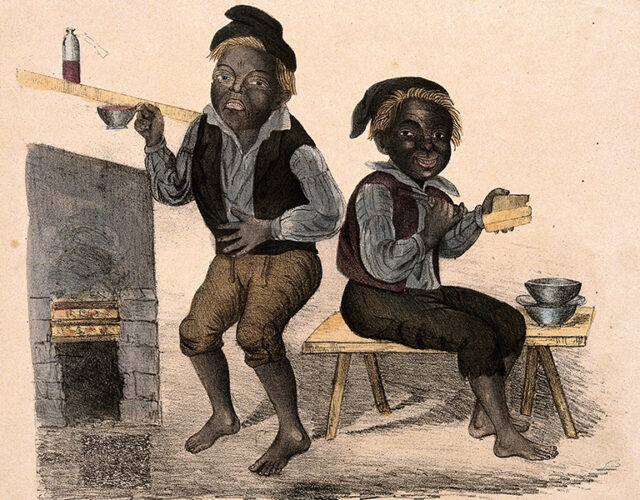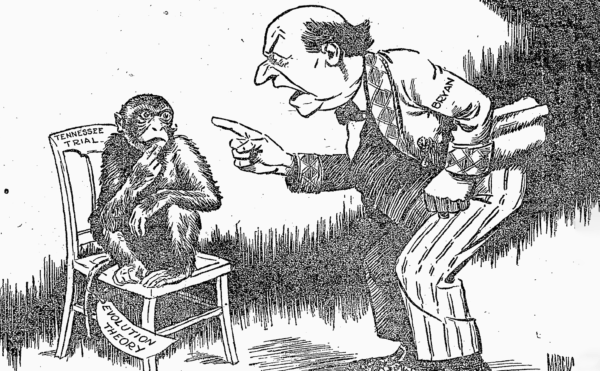In this episode of The Disappearing Spoon, Sam Kean discusses the horrors of a particular genetic disease that was, literally, sweeping through London in the 1700s. In 1666, the Great Fire of London consumed about 13,000 homes and caused the modern equivalent about $1.3 billion in damage. After the Great Fire, London officials made chimneys mandatory in all homes and buildings. All these new chimneys meant there was a big demand for sweepers. Who did they employ to clean these narrow, soot-filled chimneys you ask? Very young boys.
Credits
Host: Sam Kean
Senior Producer: Mariel Carr
Producer: Rigoberto Hernandez
Audio Engineer: Jonathan Pfeffer
Photo: Wellcome Collection
Transcript
Whenever I give book talks at schools or colleges, one of the most common questions I get is this: Were there any stories you left out of the book? Stories that you wanted to include, but didn’t?
And the answer is—yes. One story especially leaps to mind, from my book on genetics, The Violinist’s Thumb. This story didn’t make the cut for a simple, if aggravating, reason: I came across it too late in the process to include.
So today, I thought I’d right this cosmic wrong, and share this story with you all.
This story start with the Great Fire of London in 1666. <INFERNO>
It was an absolutely apocalyptic event. On September 2nd, a baker on Pudding Lane in London failed to completely put out a fire in his oven. About 1 o’clock in the morning, his house went up in flames.
Most houses then were made of wood and had thatched straw roofs. And they were crowded so close together that the fire easily jumped from building to building.
London didn’t have an organized fire brigade then, and a strong wind quickly pushed the flames down the street. The flames eventually reached some warehouses along the Thames River that stored oil and tallow, and after those caught fire, the inferno was unstoppable.
Over the next few days, the fire consumed 13,000 homes and caused the modern equivalent of $1.3 billion dollars in damage. Given that London also suffered from an outbreak of plague that year—and the fact that both events took place in a year ending in 6-6-6—well, you can see why many people believed the world was coming to an end.
And for some people, that was actually the case—namely, the iconic London chimneysweepers. It took a while, but the fire really did destroy their lives, via a genetic disease.
When most people think of genetic diseases, they probably think of something like cystic fibrosis, or hemophilia, or sickle-cell anemia. In those cases, a mutation shuts down someone’s DNA, and the person’s cells can’t function properly afterward.
But there are other, subtler types of genetic diseases as well, including the biggest genetic disease of all—cancer. Now, we normally don’t think about cancer as a genetic disease. But as the story of the chimneysweepers shows, it very much is.
After the Great Fire, city leaders in London made a decision. They never wanted this to happen again, ever. So they outlawed thatched roofs. Even though straw roofs were quintessentially English, they were now illegal.
More importantly, the city made chimneys mandatory. Before, many people just knocked a hole in the roof for smoke to escape and called it good. But no more. You had to have a proper brick chimney now.
But if chimneys made the city safer, they also had an unintended side effect. If you’ve ever peeked inside a chimney, you might have noticed something—it’s filthy up there! There’s black gunk and soot all over. And the soot inside chimneys can actually catch fire itself. As a result, a new profession arose. The more chimneys there were, the more people needed chimneysweeps.
Now, I think most of us have warm feelings about chimneysweeps. That’s probably based on watching Dick van Dyke doing a soft shoe in Mary Poppins as a kid. <POPPINS SNIPPET>
But I hate to break it to you—that movie was something of a fraud. The life of your average chimneysweep was dirty, nasty, brutish, and—as we’ll see—often short.
Most sweeps were paupers. They started as boys, sometimes just four years old. And it was terrible work. They spent all day every day scraping out filthy grime. Sometimes they even had to put out fires inside the chimneys—at four years old!
The reason they used young boys was simple. Although chimneys were mandatory now, most people couldn’t afford a big, grand chimney, just a small one. Some were just 9 inches by 14 inches. And the only people who could fit inside a 9-inch by 14-inch chimney were little children.
After a full day of work, the best-case scenario for the boys was this: They’d emerge filthy dirty, with a hacking cough, their knees scraped raw from pushing off the bricks inside the chimney. In fact, the children got so dirty that their bosses often sent them up the chimneys naked. After all, why bother dressing someone if their clothes were just going to end up grimy and black?
In the worst-case scenario, the children would get stuck inside the chimneys. Trapped there. At that point, they’d have to knock down the chimney to rescue them. Usually they pulled the boys out in time. But not infrequently the boys would suffocate up there, and they’d find only a limp, lifeless body.
But the worst part about being a chimneysweep, on top of all those other hardships, was this: that child sweeps often got cancer later in life, in their thirties or forties. And if that wasn’t bad enough, the cancer appeared in a private part of their anatomies: they’d get tumors on their scrotums. This is actually an extremely rare form of cancer, so rare that doctors called it “chimneysweep’s cancer.”
The scrotal tumors looked like small warts. And because of the warts’ location, many doctors mistook them for venereal disease. But enough cases had appeared by the 1770s that a famous British doctor named Percival Pott finally pieced together what was going on.
Like the chimneysweeps, Pott came from a poor background. His father died when he was three years old, which plunged his family into poverty. Fortunately, his mother had a distant relative who was a bishop, and the bishop took a shine to the boy
He paid for Pott to attend medical school, and Pott eventually established himself as a fashionable doctor in London. His clients included many famous intellectuals and artists, including lexicographer Samuel Johnson; the famous Shakespearean actor David Garrick; and portrait painter Thomas Gainsborough.
But because of his background, Pott also helped out the poor in London, and in the early 1770s, he documented an outbreak of scrotal tumors among chimneysweeps. In one blood-curdling passage—and I apologize ahead of time—Pott described the tumor-warts as, quote, “a superficial, painful, ragged, ill-looking sore…[that] seizes the testicle, which it enlargens, hardens, and renders truly and thoroughly distempered.” In less technical terms, yuck.
The testicles sometimes swelled to the size of a plum. Even worse, the cancer often metastasized and attacked other organs. The pain got so bad that patients sometimes cut off parts of their own scrotums with a knife or razor, just for some relief.
Now, Pott guessed that something in the chimney soot was causing the cancer. After all, few people aside from chimneysweeps came down with scrotal tumors. As we now know, Pott was correct. Coal soot contains several known carcinogens.
In addition, Pott identified three other factors contributing to the cancer. The first was nakedness. Because the boys had no clothes on, their skin was exposed directly to the soot. And as they wriggled around inside the tight chimneys, the soot got ground into their skin.
Second, the skin on the scrotum is different from the skin on other parts of the body. It’s stretchier, with lots of wrinkles and folds. As a result, the soot had plenty of places to burrow into and hide.
Third, even by the standards of the 1700s, chimneysweeps were pretty relaxed about bathing. A monarch from an earlier era, Queen Elizabeth, famously once bragged that she took a bath every single month, whether she needed to or not. Chimneysweeps didn’t meet even that standard. Because again, they were just going to get filthy dirty tomorrow, too, so why bother?
Putting all this together was some amazing medical detective work on Percival Pott’s part. But given the state of biology then, Pott couldn’t know everything. And several mysteries remained. What exactly in the soot caused cancer? Why was there a decades-long gap between when the sweeps were cleaning chimneys as children and when they got cancer as adults? And why didn’t all chimneysweeps get cancer—why did some of them escape this disease?
It turns out that the answers to all of these mysteries can be found in our DNA. Specifically, a stretch of DNA on human chromosome 17.
To be healthy, cells need to do certain things. Ingest nutrients. Grow. Divide and make copies of themselves. These are basic biological drives.
However, there’s got to be a balance with those drives—some growth, some division, but not too much for any one cell. Because if one cell does get selfish and tries to grow and divide as fast as it can and make a billion copies of itself, well, that will harm the rest of the body by diverting nutrients away from where they’re needed more. In fact, when cells do start multiplying out of control, they can turn into tumors.
So our bodies work hard to limit excessive growth through a system of checks and balances. These checks and balances set rules for how often cells can divide. And these rules are encoded in our DNA. Ultimately, then, it’s the DNA inside cells that curbs their growth.
But if the DNA that curbs growth gets damaged or suffers a mutation, suddenly the brakes are off. After this, cells can multiply out of control.
To prevent this, there’s another layer to the system of checks and balances. Our bodies make certain watchdog proteins that scour our cells and monitor for DNA damage. There’s one protein in particular that’s a vital watchdog. It’s called p53.
If p53 finds some moderate DNA damage, it emits a signal that calls over so-called handyman proteins. These handyman proteins then fix the damage, so the cell stops behaving badly.
Sometimes, though, p53 finds massive amounts of damage, something it cannot fix. In that case, p53 actually kicks off a series of chemical reactions that force the cell to kill itself.
Now, that sounds startling, but cells really do commit suicide. Within the body, no one cell is more important than the collective, and p53 is the protein that makes the call about when to sacrifice one cell for the greater good. p53 is so vital to our DNA health that it’s sometimes called the “guardian of the genome.”
Overall p53 works great. Unfortunately, there is one flaw here. p53 is a protein that our bodies make. And just like with every other protein, our bodies store the instructions for making p53 in the form of DNA, on chromosome 17.
But what happens if the very DNA for making p53 also suffers a mutation? What happens if the watchdog for DNA damage itself gets damaged? In that case, the body stops producing p53, and that vital monitoring system falls apart.
And here’s where we get back to the chimneysweeps. Chimney soot contains a chemical called benzo-alpha-pyrene. It’s made up of five carbon rings fused together.
When the sweeps were scrambling around inside the chimneys and getting filthy, the benzo-alpha-pyrene in the soot got rubbed into their skin and absorbed into their bodies.
Now, benzo-alpha-pyrene doesn’t do much damage by itself. Unfortunately, our bodies metabolize it into another, related chemical called BPDE. And BPDE is bad bad bad news.
If BPDE finds its way into your cells, it makes straight for your DNA. Normally our DNA is an elegant double helix, like a twisting ladder. But BPDE shoulders its way into the double helix, breaking the rungs of the ladder. As a result, bulges and kinks form. This damages the DNA and prevents ours cell from making the protein it’s supposed to make.
This damage would be bad enough anyway, no matter where it appeared in our DNA. But for some reason—scientists don’t know why—BPDE prefers to shoulder its way into the gene that makes p53. As a result, in people exposed to BPDE—like the chimneysweeps—this guardian of the genome got knocked out.
Now, this didn’t instantly lead to cancer. And that’s an important point: that you never get cancer from one single mutation. Again, we have a system of checks and balances with several layers to it. There’s redundancy built in. So if one part of the system fails, other parts can monitor your cells for tumors and stop them. You have a fighting chance.
But knocking out p53 is a huge blow. It cripples a cell’s ability to fix major mutations. It also decreases the odds of a highly damaged cell committing suicide, which can shut down tumors early on.
And with all that knowledge in place, we can now explain why the chimneysweeps got cancer, and resolve some of the mysteries that Percival Pott couldn’t.
The sweeps got cancer because the skin on their scrotums was highly wrinkled, which meant soot could easily hide out there, especially when they didn’t bathe often. The soot got absorbed into their bodies, which exposed them to the dangerous chemical BPDE.
BPDE shouldered its way into the double helix and shut down the production of a vital tumor-suppressing protein called p53. When p53 got knocked out, mutations started to accumulate far more easily, and a tumor often resulted. That’s why chimneysweeps were far more vulnerable to scrotal cancer than butchers, bakers, candlestick makers, and other workers in 1700s England.
But what about that lag? Why was there a gap between when the sweeps were cleaning chimneys as boys and the time they came down with cancer as adults? Well, even after p53 got knocked out, other mutations needed time to accumulate. Again, you don’t get cancer from one single mutation. Several things have to go wrong, which takes time—in this case, a few decades.
And why did some sweeps develop cancer and others didn’t? It was just luck. All the sweeps probably suffered some damage to the p53 DNA in their scrotal cells. But some of them got lucky and didn’t suffer additional damage to other cancer-suppressing DNA. As a result, they escaped the tumors.
Now again, Percival Pott didn’t know all this back then. But he did know enough to sound the alarm in 1775 about the dangers of making boys sweep chimneys. And other European nations heeded him warnings.
The Danish chimneysweeper guild suggested that, well, maybe the sweeps should take a bath now and then. More importantly, most countries adopted a characteristic chimneysweeper costume—basically a head-to-toe bodysuit that kept the soot off their skin.
But in England? There, people ignored Pott. A prophet never wins honor in his own land, and people in London kept sending naked boys up chimneys. The practice wasn’t outlawed until the 1840s, and even then people in rural areas kept using boys for another generation. Year by year, ash by ash, they kept destroying the vital bit of cancer-fighting DNA on chromosome 17.
So there it is, the one story I really regret not fitting into my books. It’s not a happy tale, obviously. But it helped me understand cancer as a genetic disease in a way I never did before. And frankly, I’ll never be able to watch Mary Poppins, or even look at a chimney, the same way again. <CHIM-CHIMNEY MUSIC>




